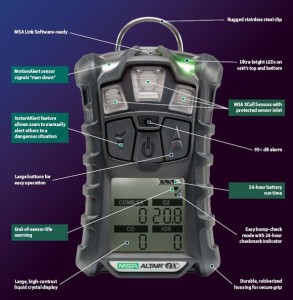Workers cannot rely on their sense of smell to alert them to odorless hazards in the workplace. Exposure to excessive levels of toxic gas or an oxygen-deficient environment can cause workers serious illness and even death. Combustible gas can lead to explosions that can be catastrophic, injuring or killing personnel and destroying property.[1]Enter the need for gas detectors. Gas monitoring instruments are designed to protect workers from unforeseen dangers by measuring, monitoring and indicating the concentration of certain gases in the atmosphere.
Gas detectors are produced as either portable or stationary devices. We will be focusing on portable gas detectors; these are hand held devices designed to detect the presence of various combustible, flammable and toxic gases, and oxygen depletion within an area. When dangerous levels of gas vapors are detected, portable gas detectors transmit audible and visiblewarning signals such as alarms and flashing lights to warn workers that a leak is occurring, giving them the opportunity to safely exit the area.
One of the most dangerous hazards occurs when the detector’s alarms are being triggered and people assume there is an instrument malfunction. Ignoring the alarms, and worse, turning off the device, will simply lead to tragedy. When an alarm is activated, ALWAYS err on the side of caution and evacuate the area.
The Importance of Calibration and Bump Testing
It is vital to worker safety that these instruments are maintained and calibrated properly. In addition, performance of a daily bump test is a best practice because it is the only method by which the entire system: instrument, sensors, flow path, power source, alarms, and all electronics can be checked to ensure that it is functioning properly. However, recently, there has been much discussion among safety professionals and users of gas detection regarding the frequency of bump testing. Best practice and most manufacturer instructions recommend a daily bump test prior to operation of gas detectors.
As products continue to evolve, durability and advancements in sensor technology continue to improve detector performance and reliability. This provided some users with a basis for abandoning the practice of daily bump tests and has resulted in some deviation from historical guidance provided by most manufacturers. MSA remains in support of a daily bump check as the best practice to ensure daily readiness of detectors.
Instrument inaccuracy due to improper or irregular calibration can lead to serious accidents. Over time, the accuracy of gas detection instruments can diverge from their calibration settings in several ways. According to OSHA Safety and Health Information Bulletin 05-04-2004 following are the potential failure modes which can be identified during a bump test.
- Gradual chemical degradation of sensors and drift in electronic components that occur naturally over time.
- Chronic exposures to, and use in, extreme environmental conditions, such as high/low temperature and humidity, and high levels of airborne particulates.
- Exposure to high (over-range) concentrations of the target gases and vapors.
- Chronic or acute exposure of catalytic hot-bead LEL sensors to poisons and inhibitors. These include: volatile silicones, hydride gases, halogenated hydrocarbons, and sulfide gases.
- Chronic or acute exposure of electrochemical toxic gas sensors to solvent vapors and highly corrosive gases.
- Harsh storage and operating conditions, such as when an instrument is dropped onto a hard surface or submerged in liquid. Normal handling/jostling of the equipment can create enough vibration or shock over time to affect electronic components & circuitry.
- In addition to these, any general component failure
In addition to good maintenance practices, safety practices also need to be reinforced regularly. Far too often, as previously mentioned, gas alarms are viewed as a nuisance or an error and are ignored by workers. It is critical that workers comprehend that the detector is utilized for their safety. Following safety protocol when alarms are triggered is a vital safety practice and could prove to be lifesaving.
More About MSA
MSA, is a maker of sophisticated safety products that help protect workers who may be exposed to a variety of hazardous conditions. MSA was started in 1914 and in the decades that have come and gone, MSA has continued to lead the charge for workplace safety. We’ve led the way with small first-aid kits and portable methane detectors, and harnessed new technologies to produce state-of-the-art thermal imaging cameras, ballistic helmets, and leading edge systems for gas and flame detection.
For more information contact: Amy C. Puff Office Phone: 724-776-8738 Mobile Phone: 724-719-7175 MSA - The Safety Company 1000 Cranberry Woods Drive Cranberry Twp, PA 16066
[1] U. S. Department of Labor, Occupational Safety and Health Administration, Verification Of Calibration for Direct-Reading Portable Gas Monitors, (05-04-2004), www.osha.gov/dts/shib/shib050404.html
The article above was published through EagleFordShale.com’s press release distribution service. Learn more about Eagle Ford Advertising Here.

